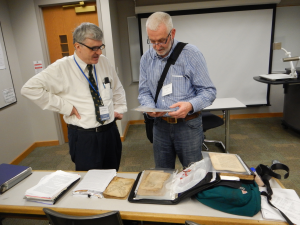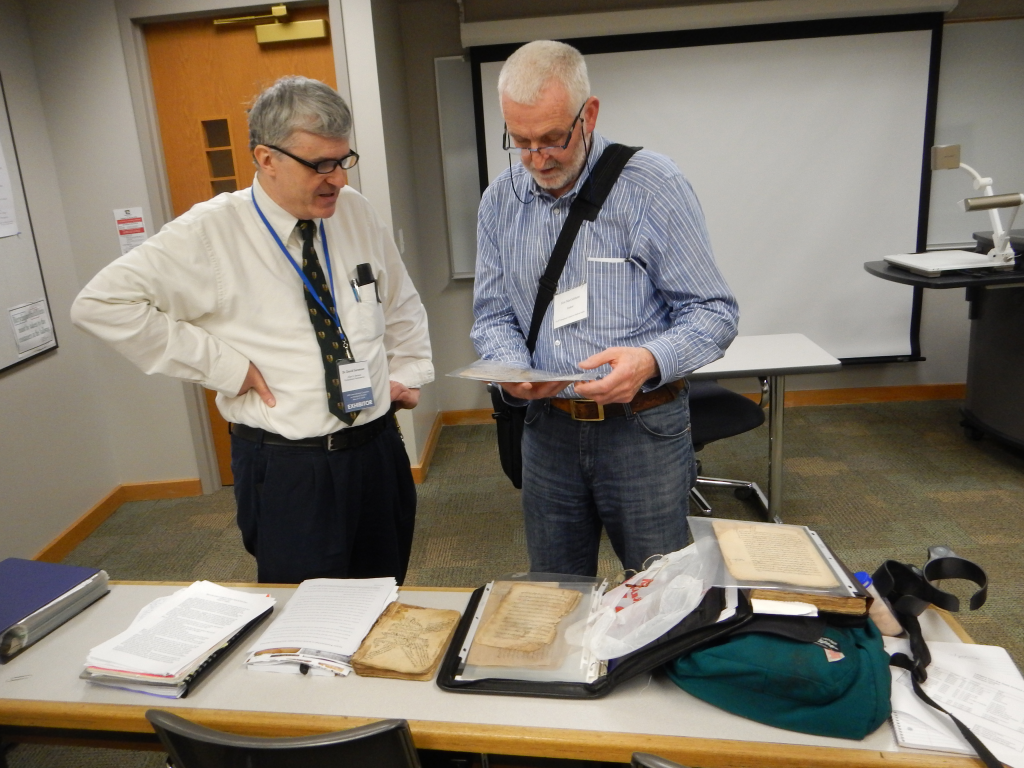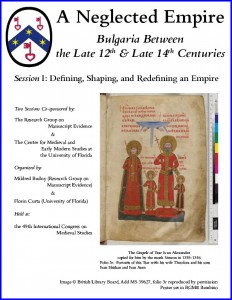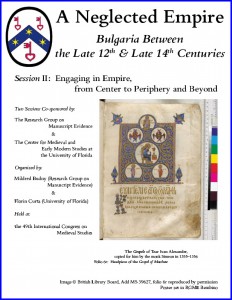2014 Congress Report
June 25, 2014 in Abstracts of Conference Papers, Bembino, Conference Announcement, ICMS, International Congress on Medieval Studies, Kalamazoo
49th International Congress on Medieval Studies
An Anniversary Year
8-11 May 2014
[Published on 25 June 2014, with updates]
Our sessions at the 2014 Congress formed part of the celebrations for our anniversary year. 2014 marks our 15th anniversary as a nonprofit educational organization and our 25th anniversary as an international scholarly society. At the Congress, we both sponsored sessions and co-sponsored sessions, as before, with the Societas Magica, in the eighth year of this co-sponsorship, and, for the first time, with the Center for the Study of Medieval and Early Modern Studies at the University of Florida. As is our practice, various of our Trustees, Officers, and Associates participated in these and other sessions at the Congress.
We held altogether five sponsored and co-sponsored Sessions, in part to celebrate combined anniversaries. We celebrated the 15th anniversary of the Research Group on Manuscript Evidence as a nonprofit educational corporation based in Princeton, and its 25th anniversary as an international scholarly society. We also celebrated the many contributions by individuals and organizations, as well as individuals within organizations, to our mission, activities, and collaborations over the years. The celebrations included a reception for both the Societas Magica and the Research Group on Manuscript Evidence.
I. Sessions Sponsored by the Research Group on Manuscript Evidence
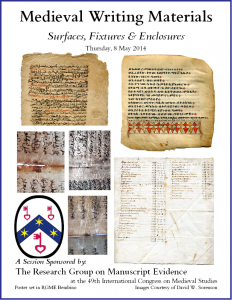 1. “Medieval Writing Materials:
1. “Medieval Writing Materials:
Surfaces, Fixtures, and Enclosures”
This fourth session in our recurring series on “Medieval Writing Materials” at the Congress focused upon subjects and methodologies which call for attention, in turn or in further refinement, in response to new or continuing research. Among topics for consideration were the production, trade, and use of medieval writing materials, and the artful combinations of form and contents in their very surfaces, substances, and enclosures. The case studies considered the evidence for the evolution of Christian manuscript production in Ethiopia from its origins onward, the significance of the materials employed in the records for the Catalan companies of Francesco di Marco Datini da Prato, and the features of specimens of European watermarked paper in Early Ottoman contexts.
Organizer: Mildred Budny (Research Group on Manuscript Evidence)
Presider: Alan M. Stahl (Firestone Library, Princeton University)
Presenters:
- Sean M. Winslow (Centre for Medieval Studies, University of Toronto)
“The Gospels of Ǝnda Abba Gärima and the Contexts of Early Christian Manuscript Production in Ethiopia”
Abstract: Winslow (2014 Congress)
- Eleanor A. Congdon (Department of History, Youngstown State University)
“The Paper Used in the Account Books of Francesco di Marco Datini da Prato”
Abstract: Congdon (2014 Congress)
Respondent:
- David W. Sorenson (Quincy, Massachusetts)
“European Watermarked Paper in the Early Ottoman Empire: Some Preliminary Observations”
Abstract: Sorenson (2014 Congress)
This Session formed the fourth in our annual series on “Medieval Writing Materials” at the Congress since 2011:
[A fifth occurred at the 2016 Congress.]
As before, Dr. Sorenson generously contributed the images for the posters for this year’s Sessions and provided a display of original manuscript materials (on paper and vellum in various languages) for examination and discussion at the Materials Session.
2. “Individual Style or House Style?
Assessing Scribal Contributions, Artistic Production, and Creative Achievements”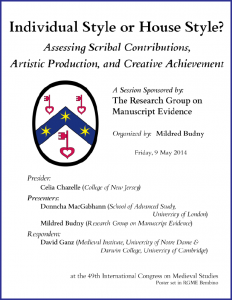
Our session explored the complex issues of recognizing, and distinguishing between, “Individual Style” or “House Style” in the hands of scribes, artists, and others creating distinctive works of whatever kind. Contributions and comments in our recent sessions and other settings have made it clear that these issues of attribution impact numerous areas of study — Insular manuscripts, Carolingian workshops, Middle English palaeography, to name a few — while a suitably rigorous methodology deserves wider application. The contributions discussed diverse areas of subject matters and research results, which the discussion both extended and enriched.
Organizer: Mildred Budny (Research Group on Manuscript Evidence)
Presider: Celia Chazelle (Department of History, The College of New Jersey)
Presenters:
- Donncha MacGabhann (School of Advanced Study, University of London)
“Half-Uncial a and Uncial a at Line-Ends: The Division of Hands in the Book of Kells and an Insight into the ‘Calligraphic Imagination’ Evident in the Script”
Abstract: MacGabhann (2014 Congress) - Mildred Budny (Research Group on Manuscript Evidence)
“Variability or Multiple Identities? A Question of Style, Constraints, and Potential”
Abstract: Budny (2014 Congress)
Respondent:
- David Ganz (Medieval Institute, University of Notre Dame, and Darwin College, University of Cambridge)
“Polygraphism”
II. Co-sponsored Sessions
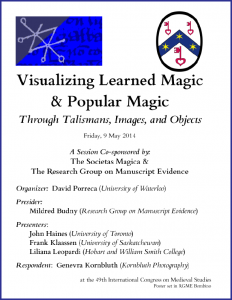 3. “Visualizing Learned and Popular Magic Through Manuscripts, Objects, and Talismans”
3. “Visualizing Learned and Popular Magic Through Manuscripts, Objects, and Talismans”
Co-sponsored by the Societas Magica and the Research Group on Manuscript Evidence
This session examined the archaeology of magic as it manifests over a broad temporal and geographic area. The talks considered magical objects from both East and West. What objects (talismans, tomes, sculptures, inscriptions, etc.) relevant to magic survive from the Medieval era? What marks their ritual use and/or how do they distinguish themselves from ordinary artifacts?
Organizer: David Porreca (Department of Classics, University of Waterloo)
Presider: Mildred Budny (RGME)
Presenters:
- John Haines (Faculty of Music, University of Toronto)
“The Musical Hand of Knowledge”
Abstract: Haines (2014 Congress) - Frank Klaasen (Department of History, University of Sasketchewan)
“The Visual Trappings of Magic: McGill University, Special Collections, MCG 117”
Abstract: Klaassen (2014 Congress) - Liliana Leopardi (Hobart and William Smith Colleges)
“Riding the Emerald: Lithic Talismans in Renaissance Visual Culture”
Abstract: Leopardi (2014 Congress)
Respondent:
- Genevra Kornbluth (Kornbluth Photography), “Hands, Gems, and Geometry”
4-5. “A Neglected Empire:
Bulgaria Between the Late 12th and Late 14th Centuries (I and II)”
Co-sponsored by the Research Group on Manuscript Evidence and the Center for Medieval and Early Modern Studies at the University of Florida
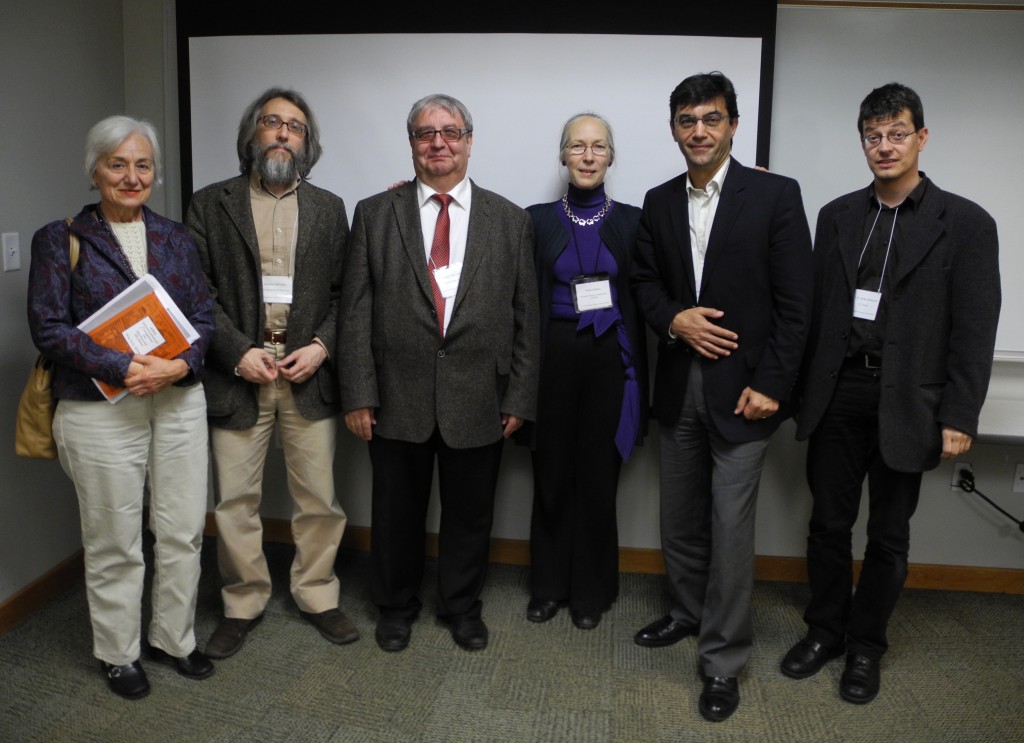 Organized by Mildred Budny (RGME) and Florin Curta (Department of History, University of Florida)
Organized by Mildred Budny (RGME) and Florin Curta (Department of History, University of Florida)
One of the most neglected European polities of the High and Late Middle Ages is the so-called “Second Bulgarian Empire” (1186–1396). Its history is moreover connected to the rise of Cuman power in the steppe lands north of the Black Sea, the medieval kingdom of Hungary, medieval Serbia, and the Latin Empire of Constantinople. Pope Innocent III wrote several times to Johannitsa Kaloyanes, the second ruler of the Empire. John Asen II won a great victory at Klokotnitsa against the Despotate of Epirus, thus enabling the rise of the Nicaean Empire, as well as the subsequent restoration of the Byzantine Empire in 1261. The lavishly decorated Tetraevangelion of Emperor John Alexander (now preserved in the British Library and illustrated on our Posters for these Sessions) is perhaps the best known “icon” of the extraordinary cultural development which occurred in 14th-century Bulgaria.
Our sessions examined this “exotic” subject, little-known among Western medievalists, of the history of Southeastern Europe between the late 12th and the late 14th centuries. Our goal was to showcase recent research on the legal history of the Empire, the relations between Catholic and Orthodox Christianity in the political and cultural achievement of medieval Bulgaria, manuscript transmission, and fashions combining Western and Byzantine elements (revealed primarily through archaeological finds in medieval cemeteries in Silistra). Our explorations shed new light on this “neglected empire” of medieval Europe.
Note: We thank the British Library Board for permission to reproduce images from the superb Gospels of Tsar Ivan Alexander in the two Posters for our pair of Sessions, not only for publicising the Sessions at the Congress, but also here on our website.
Part I. “Defining, Shaping, and Redefining an Empire”
Presider: Florin Curta (Department of History, University of Florida)
[Note: For reasons of travel funding and visas, Ivan Biliarsky, Kirił Marinow, and Mariyana Tsibranska-Kostova were unable to attend the Congress to present papers. The Abstracts for their intended papers demonstrate the nature and scope of their subjects and approaches.]
- [Ivan Biliarsky (Institute of History, Bulgarian Academy of Sciences, Sofia, Bulgaria)
“The Second Bulgarian Empire: Identity, Typology, Continuity, and Discontinuity”
Abstract: Biliarsky (2014 Congress) - Dmitriy I. Polyvyannyy (Ivanovo State University, Russia)
“Sources and Patterns of State Identity of the Bulgarian Empire under the Assenids (1186–1396)
Abstract: Polyvyannyy (2014 Congress) - Francesco dall’Aglio (Italian Institute for Historical Studies, Naples, Italy)
“Between Past Glory and Imperial destiny: The Ideological Use of the Past and of the Imperial Idea in 13th-Century Bulgaria”
Abstract: dall’Aglio (2014 Congress) - Elisaveta Todorova (Department of History, University of Cincinnati)
“The Second Bulgarian Empire and the Mediterranean”
Abstract: Todorov (2014 Congress)
Part II. “Engaging in Empire, from Center to Periphery and Beyond”
Presider: Francesco dall’Aglio (Italian Institute for Historical Studies, Naples, Italy)
Presenters:
- [Kirił Marinow (Department of Byzantine History, University of Łódź, Poland)
“The Empire’s Heart: The Significance of the Capital Tărnovo in the History of Late Medieval Bulgaria”
Abstract: Marinow (2014 Congress))] - [Mariyana Tsibranska–Kostova (Institute for Bulgarian Language, Bulgarian Academy of Sciences, Sofia, Bulgaria)
“Anti-Heretical Texts in 14th-century Bulgarian Compilations of Canon Law”
Abstract: Tsibranska-Kostova (2014 Congress)] - Stefan Rohdewald (Historical Institute, East-European History, Justus Liebig University, Giessen, Germany)
“Within a Southeast European Multiple-Contact Zone: The Conceptualization of Medieval Bulgarian and Early Ottoman History”
Abstract: Rhodewald (2014 Congress)
III. Reception for the Societas Magica and the Research Group on Manuscript Evidence
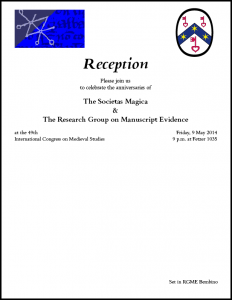 For the first time this year, there was a Reception for the Societas Magica and the Research Group on Manuscript Evidence, to celebrate the anniversaries of our collaborating organizations in this landmark year. We describe it here: Anniversary Reception May 2014.
For the first time this year, there was a Reception for the Societas Magica and the Research Group on Manuscript Evidence, to celebrate the anniversaries of our collaborating organizations in this landmark year. We describe it here: Anniversary Reception May 2014.
IV. Corrigenda
Some changes and corrections to the advertised program appear in the published Corrigenda for the Congress, as distributed to participants upon arrival there, and now [but no longer] available on the Congress website as such [now incorporated in the archived Congress 2014 Program]. Here we report the full set of corrections, including a last-minute change too late to be included in those Corrigenda.
Sessions 348 and 402: For reasons of travel funding and visas, Ivan Biliarsky, Kirił Marinow, and Mariyana Tsibranska-Kostova were unable to attend the Congress to present papers or to preside; Francesco dall’Aglio presided instead in Session 402.
*****
Information about the International Congress on Medieval Studies and the Societas Magica appears on their websites:
The Center for Medieval and Early Modern Studies at the University of Florida reports its 2014 Congress activities.
Information about our sessions in previous Congresses appears on our pages on
Please watch this page and these sites for developing information about the next Congress. The Call for Papers for the 2015 Congress has appeared. Further updates for that Congress and the next are available for our Congress Activities.
*****

